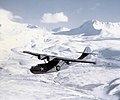|
Carrier Aircraft Service Units
   Carrier Aircraft Service Units (CASU) were United States Navy units formed during World War II for the Pacific War to support naval aircraft operations. From 1942 to 1946, 69 Carrier Aircraft Service Units were formed to repair and maintain aircraft. The first unit was deployed to Naval Station Pearl Harbor. The CASU-11, was deployed on January 22, 1943 at Naval Air Station San Diego. During the war the Navy lacked enough aircraft carriers to complete all the operational requirements.[1] HistoryIn 1942, Ewa Field at Naval Base Hawaii became a major United States Marine Corps and US Navy aviation training facility for Carrier Aircraft Service Units (CASU). Flight crews and air mechanics trained at Ewa Field for the upcoming Pacific War, including Battles at Wake Island, Guadalcanal, and Midway. Aircraft mechanics of Carrier Aircraft Service Units traveled with the island hopping troops as new airfields were built across the Western Pacific Ocean. The many aircraft fighting and patrolling the South West Pacific theatre of war needed ongoing maintenance. CASU-11 was deployed for three years and nine months. CASU-11 decommissioned on November 1, 1946, at Naval Air Facility Yonabaru Okinawa with the war over.[2] In that time CASU-11 traveled over 1,700 troops worked in CASU-11 and the unit traveled over 27,000 miles. CASU-11 worked on Naval planes at Naval Air Stations from Guadalcanal to Okinawa. Carrier Aircraft Service Units worked on seaplanes, fighter planes, bombers torpedo planes, dive bombers, and later night fighters. Out of necessity Carrier Aircraft Service Units sometimes worked on marine craft, United States Army Air Forces and other allied aircraft. Carrier Aircraft Service Units worked on aircraft carrier planes and land-based planes. Some Carrier Aircraft Service Units worked in United States on training aircraft and other planes. If needed a Carrier Aircraft Service Unit could be redesignated into a Combat Aircraft Service Unit, Scout Observation Service unit or Patrol Service units.[3][4][5]
Combat Aircraft Service UnitsCombat Aircraft Service Unit, CASU (F), units operated out of US Naval Forward Advance Bases and were noted as CASU (F), [F] indicated Forward operations.[6] Scout Observation Service unitsScout Observation Service units, (SOSU) were like Carrier Aircraft Service Units but specialized on scout observation planes. Scout observation planes operated from battleships, cruisers and a few destroyers.[4] Patrol Service unitsPatrol Service units, (PatSU) were like Carrier Aircraft Service Units but specialized on maintaining land-based patrol aircraft. These units specialized on the Navy's land-based PB4Y-1 Liberator patrol bomber and later the Consolidated PB4Y-2 Privateer aircraft. [4] Blimp HedRonBlimp HedRon, Blimp Headquarters Squadron, were Navy units that maintained US Navy blimps in the Lighter-than‑air (LTA) service. Blimp HedRon operated much like Carrier Aircraft Service Units but specialized in fabric damage and helium handling. Lighter-than‑air operations extended into the South Atlantic and Caribbean areas (for example from Naval Base Trinidad).[4][7]   Aircraft repair shipsSome cargo ships and LSTs were converted into Aircraft repair ships to aid in the repair needs of the island hopping campaign.[4][8][9] Seaplane TenderThe US Navy operated a fleet of Seaplane tender used to maintain the many US navy Seaplanes. Some Seaplane tenders were cargo ships converted into Seaplane tenders. The USS Curtiss (AV-4) was the first ship built to be a Seaplane tender. Seaplane tender serviced and repaired seaplanes used in forward bases used for long-range patrol. Seaplane Tenders were able to do repair and maintenance and had all the supplies needed to operate in remote forward bases for months. Once and if a land-based forward base was built the Seaplane tender could move on to a more forward base. Seaplane tenders acted as barracks, supply depots, workshops, air mechanic and control towers for the planes.[10][11][12] PartsThe key to the Service Units was the supply of parts, keeping supply depots stocked with the needed parts. Both the UN Navy and the World War II United States Merchant Navy kept parts from the states flowing to the Advance Bases where they were needed.[4][13] Gallery
See alsoWikimedia Commons has media related to Seaplane tenders. Wikimedia Commons has media related to Seaplane tenders of the United States. Wikimedia Commons has media related to K-class blimps. Wikimedia Commons has media related to Consolidated PBY Catalina.
External links
References
|
||||||||||||||||
















